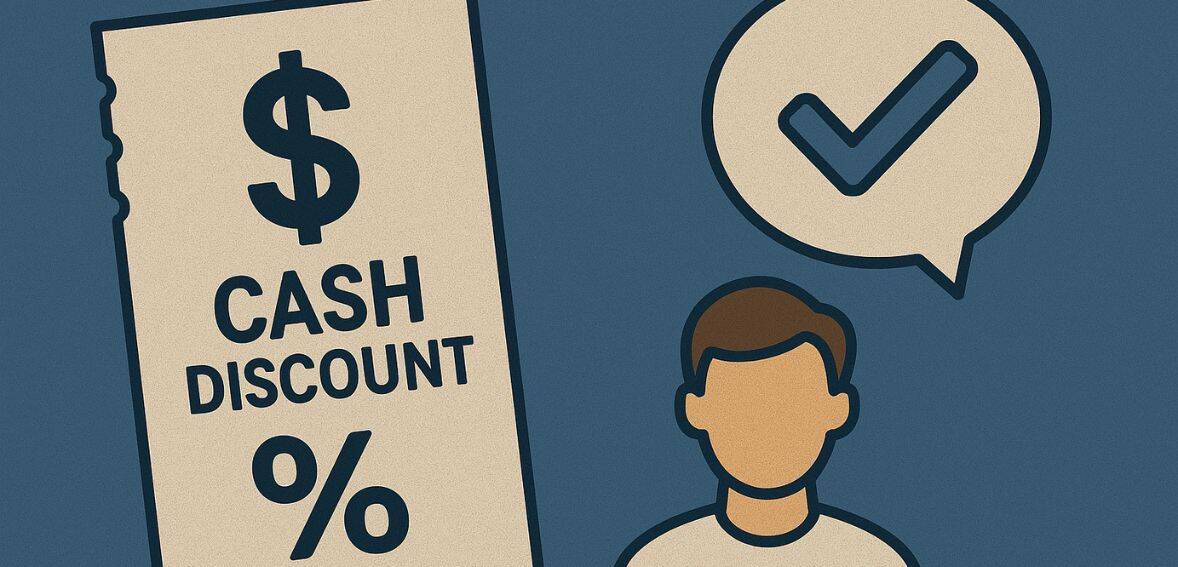
By alphacardprocess July 16, 2025
Offering cash discounts may seem outdated in today’s digital world, where credit and debit cards are widely used. To lower credit card processing fees and provide customers with a way to save money, many business owners have revisited this idea. Is it true that consumers prefer cash discounts? Is it a successful strategy? In this article, we’ll examine how business owners utilize cash discounts and what consumers think of them. We’ll determine whether cash discounts are worthwhile for contemporary businesses by examining real-world examples and the variables that affect consumer choices.
Why Cash Discounts Have Reappeared in Modern Retail

When card technology initially became popular, it was hard to resist the allure of rewards, convenience, and safety. However, there is a fee associated with each swipe, usually between one and three percent of the sale, which is reimbursed to the issuing banks. These fees are subtly reducing profits for many companies, particularly those with narrow profit margins. In order to shift that cost back to payment behavior without explicitly raising prices, cash discounts are making a comeback.
Offering discounts for cash encourages customers while maintaining price optics, as opposed to passing on credit-card fees through surcharges, which present legal and branding issues. Merchants are therefore more at ease capturing value and portraying it as a benefit to customers rather than a hidden expense.
Customer Behavior: Convenience vs. Saving
Cash is tangible. Swiping a card doesn’t feel like real money; holding a few bills in your hand does. This tangibility influences people’s spending habits, as psychologists have long noted. A mental reward is produced when a few dollars are subtracted from the total: “I’m saving something, and it feels good.” Cash discounts may be alluring because of this emotional reward.
Convenience, however, competes with that automatic association. Consumers of today demand simplicity. Pay, tap, and proceed. The lure of a small percentage off can be overcome by any mental resistance, such as retrieving cash from a wallet, making sure you have exact change, or worrying about safety. Unless it is significant or strongly reinforced, many people find that the friction cost of handling cash outweighs the discount.
Context Matters: Small Shops vs. Chain Stores

A more complex picture is presented by independent merchants. Cash discounts seem more genuine in quaint, walk-in boutiques and neighborhood cafés. During the busy holiday season, a prominently displayed sign offering 3% off for cash payments translated into a surprising 20% of transactions paid that way, according to one gift shop owner in a coastal town.
The cashier’s kind reminder was enough to get them to take action, and for that group of people—retirees and returning residents—it was a welcome savings. However, the same discount hardly registers at a tourist trap café or a busy chain store. Contactless habits are deeply entrenched in visitors, ranging from local millennial shoppers to seasonal travelers. It doesn’t seem worth the work or risk to carry extra cash for a 3% reduction.
So while cash discounts may work in targeted micro-institutions with close customer relationships, their power weakens in high-traffic, convenience-driven environments.
The Ingredients of a Successful Cash Discount Strategy
Looking across these scenarios, three ingredients appear essential for successful cash discount programs to take hold:
- Genuine savings
The impression of significant savings is the most important of these. A 2–5% discount, or $10–$15 off expensive items, can encourage behavior in a sustainable way. Anything that falls below these ranges frequently doesn’t seem worth the effort.
- Clear Communication
It matters how the discount is offered. Customers will become resentful if they feel punished for using cards instead. Rather, saying, “We’re happy to pass our savings on to you,” conveys warmth and promotes goodwill. When employees are empowered with a humane, approachable approach—“Paying in cash today saves you a few dollars if you’d like”—the message is delivered gently but effectively.
- Lifestyle and Customer Demographics
The type of customer—local regular versus one-time visitor, older versus tech-first newcomer—makes a significant difference. Greater incentives are needed to bring about behavioral changes in communities where digital habits are deeply ingrained. On the other hand, older customers in close-knit communities who are already comfortable with cash are more likely to gravitate toward it.
Operational Considerations: Balancing Benefits and Bottlenecks

There are operational implications to cash discounts. Counting envelopes, protecting tills, and making more bank trips are all necessary when there is more money in the drawer. Dual pricing must be managed by staff, and your accounting system must effectively track both cash and card sales—ideally with integrated point-of-sale software or systematic bookkeeping.
Additionally, there is the issue of compliance. Your state’s surcharging laws may have an impact on how you offer and carry out discounts, especially when compared to no-fee processing models. To avoid misunderstandings, transparent displays and meticulous receipt formatting are essential. To make integration and record-keeping easier, some banks or payment processors may even incorporate cash-discount modules into their point-of-sale (POS) systems.
Another major worry is security. Tighter protocols—such as drawer locks, cash drop safes, and potentially insured pickups—are necessary when there is more cash on hand. While the profits may offset these new pressures, they cannot be ignored. Merchants emphasize that if managing cash becomes a logistical burden, the value proposition quickly flips.
Evolving Strategy: Cash Days and Hybrid Incentives
Some merchants have found success with selectively launching cash-discount promotions rather than consistently offering discounts. Offered once or twice a week, or on designated slow days, these “cash days” create theater, create excitement, and increase adoption rates. Hybrid models that combine swipe-based incentives with small cash discounts are also becoming more popular.
Offering loyalty points, freebies, or digital tickets on cards, for instance, keeps value regardless of the method of payment. By rewarding swipe payments, this well-balanced strategy reduces the friction associated with cash and maintains the brand’s modernity while providing customers with flexible value.
Beyond Cash: A Broader View on Payment Value Strategies
Redefining value across all methods is the current challenge for many merchants, rather than refusing digital payments. In some situations, cash discounts are effective, but fingered incentives that encourage card usage—like accumulating loyalty miles or discount coupons for online purchases—are frequently a better fit.
Today’s consumers are used to having options, but they must be quality-valued. Well-designed payment incentives have the power to increase engagement, foster loyalty, and even encourage upsells. The secret is not just in pricing but also in empowering customers, whether the stickers read, “Pay with cash, save now!” or “Swipe with points—earn later!”
How Regional Attitudes Impact Cash Discount Reception
Customers’ geographic location and local spending patterns are frequently disregarded when determining how they react to cash discount programs. Card use is commonplace and rarely questioned in urban areas where digital payments are heavily relied upon. Customers in these areas frequently anticipate tap-and-go options and consider it odd when a business accepts cash.
Smaller towns and communities, on the other hand, where cash is still the preferred form of payment, are typically more open to such discounts. Rural small business owners, for instance, have stated that their clients value even small discounts when they opt to pay with cash. It feels comfortable, intimate, and consistent with how many people have always managed their finances.
In urban areas, however, a request to use cash or pay a surcharge for using a card might feel like an inconvenience. Customers in these areas are more likely to walk away if they feel like they’re being penalized for paying the way they usually do. The kind of business is another factor. In both urban and rural locations, cash discount programs are frequently more successful for restaurants, convenience stores, gas stations, and small service providers like barbers or auto repair shops.
Because transactions in these settings typically have low dollar values, a customer may feel that saving two to three percent on a $40 purchase was worthwhile. Determining whether to implement a cash discount requires an understanding of the payment culture in your area. Business owners who pay attention to how their community thinks and what it values tend to craft better messaging around the program, making it feel like a benefit, not a pushback against card fees.
The Bigger Picture: Trust, Transparency, and Relationship

The emphasis on trust and transparency is what most distinguishes the stories that were shared. Customers are more likely to respond favorably when cash discounts are presented as friendly and helpful. The strategy backfires when they come across as unstated costs or passive-aggressive discouragement.
Words spread quickly in smaller communities. A reasonable, well-explained discount plan enhances brand recognition and fosters goodwill. And any advantage—obtained through improved processing management—matters as margins get thinner.
Conclusion
There isn’t a single, universal response to the question of whether or not customers prefer cash discounts. How your business conveys the value of the discount, who your customers are, and whether the offer feels like a reward or a restriction will all play a role. Entrepreneurs are discovering that the narrative and experience surrounding a policy are more important to success than the policy itself. Every little thing counts, whether it’s a helpful explanation from the cashier, a strategically placed sign, or the ability to pay online without using a credit or debit card.
The idea of a cash discount will probably change along with how people pay; some consumers will still welcome the chance to save money, particularly if it’s made simple and considerate of their preferences; others will prioritize convenience over savings; however, if business owners can adjust to both, they have a better chance of not only reducing processing fees but also fostering stronger, more enduring relationships, which benefits both the client and the company.